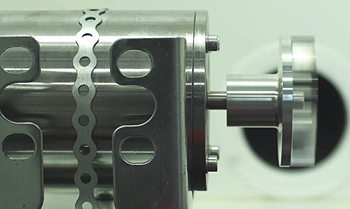- Home » News » Technology News
Nanotube windings could revolutionise motor designs

Researchers in Finland have built an electric motor that uses a carbon nanotube yarn instead of conventional copper windings. They believe that the development could lead to lightweight motors with much lower losses than traditional designs, which could revolutionise the motor industry.
The demonstration motor, built by the researchers at Lappeenranta University of Technology (LUT), has an output power of 40W, and efficiency of almost 70%, and rotates at 15,000 rpm.
Carbon nanotube (CNT) materials, formed from cylindrical carbon molecules, can achieve conductivities much higher than the best metals. Windings made from CNTs could have at least double the conductivity of the present-day copper windings.
“If we keep the electrical machine design parameters unchanged and only replace copper with future carbon nanotube yarns, it is possible to reduce the Joule losses in the windings to half of the present-day machine losses,” says Professor Juha Pyrhönen, who has led the development of the LUT prototype motor.
“Carbon nanotube yarns are significantly lighter than copper and also environmentally friendlier,” he adds. “Therefore, replacing copper with nanotube yarns should significantly reduce the CO2 emissions related to the manufacturing and operating of electrical machines. Furthermore, the machine dimensions and masses could be reduced. The motors could also be operated in significantly higher temperatures than the present ones.”
Although copper has the second-best conductivity of any metal at room temperature, much of the electrical losses in motors occur in the copper windings. These Joule losses are often referred to as copper losses.

At present, there is no known upper limit for the conductivity of carbon nanotube yarns. Values of 100MS/m (megaSiemens per metre) have been measured already. By comparison, the conductivity of copper is 59.8MS/m.
LUT’s prototype motor uses carbon nanotube yarns that have been spun into a multi-fibre yarn and converted into a tape format by a Japanese-Dutch company, Teijin Aramid, which has developed the spinning technology in collaboration with Rice University in the US.
Industrial applications for the new material are still in their infancy. Production capacity needs to be scaled up and the yarn performance could be improved further.
“There is a significant improvement potential in the electrical machines, but we are now facing the limits of material physics set by traditional winding materials,” says Dr Marcin Otto, business development manager at Teijin Aramid. “Superconductivity appears not to develop to such a level that it could, in general, be applied to electrical machines. Carbonic materials, however, seem to have a pole position.
“We expect that in the future, the conductivity of carbon nanotube yarns could be even three times the practical conductivity of copper in electrical machines,” he adds. “In addition, carbon is abundant, while copper needs to be mined or recycled by heavy industrial processes.”





